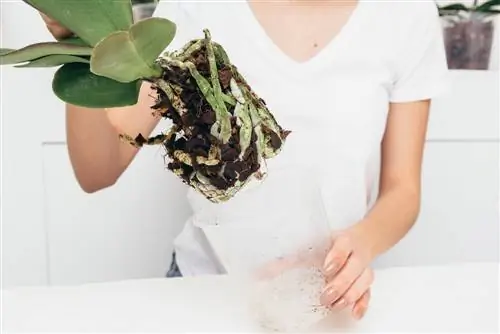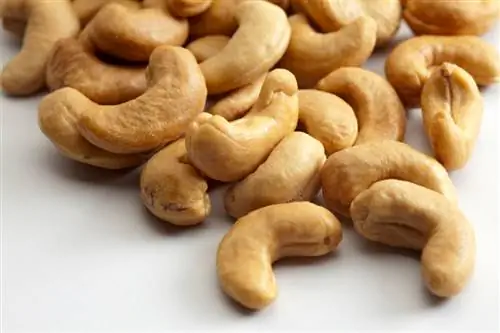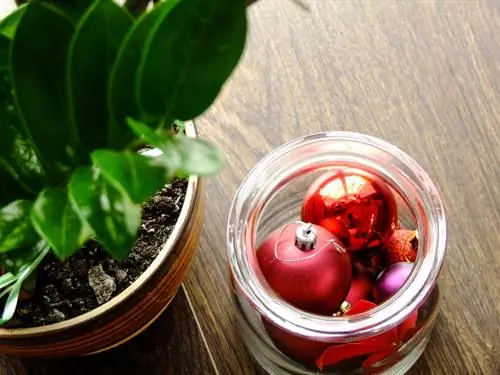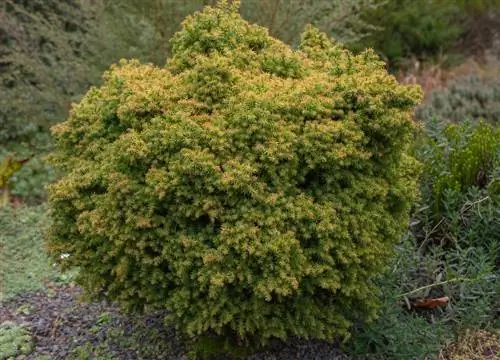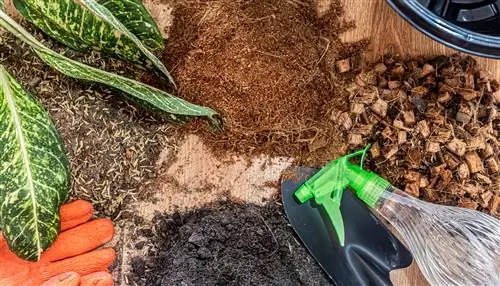- Author admin [email protected].
- Public 2023-12-16 16:46.
- Last modified 2025-06-01 06:02.
Good orchid soil simulates the natural conditions under which Phalaenopsis, Dendrobium and other orchid species thrive. This guide explains in detail what components the ideal substrate is made up of. Which orchid soil products came out on top in the test will no longer be hidden from you here. Practical instructions explain how to make the best soil for your orchids yourself.
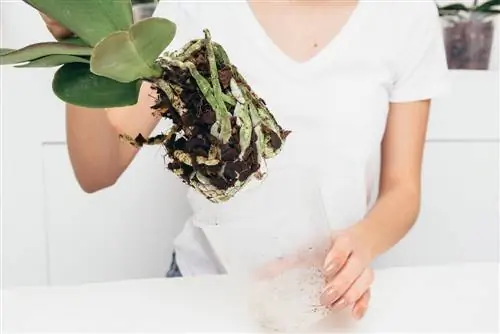
What is the best soil for orchids?
The best orchid soil is an airy mixture of pieces of bark (often pine bark) as the main ingredient, supplemented with organic and inorganic components such as coconut fiber, sphagnum moss and lava granules. Respected orchid soil products include GREEN24, Waterbirds, Compo Sana, Floragard and Kölle's Beste.
- Best orchid soil is an airy mixture with pieces of bark as the main ingredient as well as organic and inorganic components.
- Tropical orchids grow as epiphytic epiphytes and require special orchid soil, beyond conventional potting soil.
- Orchid lovers with experience make orchid soil themselves. Beginners buy test winners in premium quality.
Buy orchid soil - which one is the best?
Beginners in orchid care look at the unusual substrate in amazement. Phalaenopsis and other windowsill orchids reside in coarse pieces of bark and not in traditional potting soil. In fact, tropical and subtropical orchids grow as epiphytes high up in the crowns of mighty rainforest trees, where they cling to the branches with their roots. The following table lists premium products for orchid soil by name with information on important properties and the usual commercial price (€6.00 on Amazon) level:
| Name | 3 Top Features | Test Rating | Price (€6.00 on Amazon) |
|---|---|---|---|
| GREEN24 | + fresh bottling | Test winner | from 9.95 EUR/10 l |
| + grit of your choice | |||
| + peat-free | |||
| Waterbirds | + steamed pine bark | Top recommendation | from 16.95 EUR/5 l |
| + peat-free | |||
| + Coconut fibers, expanded clay | |||
| Compo Sana | + Pine bark | Price (€6.00 at Amazon)/performance winner | from 5, 29 EUR/5 l |
| + pre-fertilized for 8 weeks | |||
| + certified manufacturer | |||
| Floragard | + Pine bark, coconut chips | Top tip for organic gardeners | from 5.99 EUR/5 l |
| + pre-fertilized with guano | |||
| + peat-free | |||
| Kölle’s Best | + Pine bark, coconut chips | Gardener Quality | from 5.49 EUR/5 liters |
| + with sphagnum | |||
| + structurally stable |
The list of the best orchid soil products is rounded off with an insider tip for environmentally conscious indoor gardeners. Under the product name GREEN-PIK LAT you can buy an orchid soil that is pre-fertilized with organic worm compost and of course does not contain white peat. A special species of earthworm produces an organic fertilizer for orchids, rich in valuable enzymes, he althy vitamins and important trace elements. If you want to cultivate your orchids in harmony with nature, you can't ignore this premium substrate. The purchase price is an acceptable EUR 8.49 for 4 l.
Excursus
Orchid soil for other plants
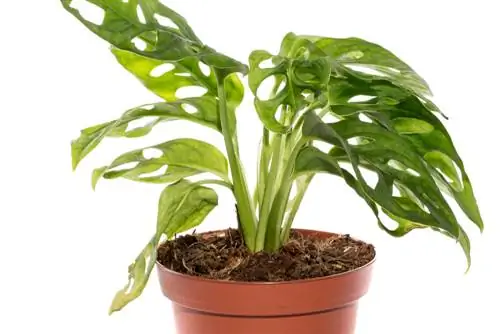
Other plants with roots that like air also benefit from orchid soil
Airy orchid soil is perfect for all epiphytic plants. Coarse pieces of bark not only provide reliable support for orchid roots. The illustrious circle of exotic epiphytes that thrive vitally in orchid substrates includes bromeliads (Bromeliaceae), dragon trees (Dracaena), window leaf (Monstera), tree friends (Philodendron) and tropical ferns of all kinds.
Make your own orchid soil - instructions for beginners

On the way to becoming an ambitious orchid whisperer, indoor gardeners accumulate a we alth of experience. As our know-how increases, the best orchid soil from the store shelf no longer meets our high expectations. Experienced orchid gardeners develop an individual substrate recipe that is optimized and refined over time. The following table lists important components for a substrate in top shape:
| Main ingredient | organic addition | inorganic addition |
|---|---|---|
| Pine bark | Coconut fibers | lava granules |
| Oak bark | Wood fibers | expanded clay |
| Douglas fir bark | Sphagnum moss | Perlite |
| Pine bark | Cork | Rockwool |
For good reason, white peat and black peat are not included in the list of the basic components of orchid soil. Nature-oriented indoor gardeners have banned all peat from the care program for orchids and other pot flowers. In order for the tropical rainforest beauties to appear magnificently on the windowsill, there is no need to plunder local moorland landscapes. Fast-growing raw materials fulfill their role as organic components just as well as coconut fibers or sphagnum moss. Are you wondering about the optimal mix of the ingredients mentioned? Then read on here because there are two recipe suggestions for medium and small orchids.

Orchid soil can also be mixed at home
Recipe for medium-sized orchids
You will look in vain for the only true patent recipe for the best orchid soil. Nevertheless, over the course of many decades of experience, the following recipe has proven to be suitable for medium-sized orchids such as Phalaenopsis and Dendrobium:
- 5 parts pine bark, medium coarse
- 2 parts coconut soil or sphagnum
- 1 part lava granules
- 1 part Perlite
- 1 part nutshells
- 1 piece of charcoal
A slight modification is enough to adapt this recipe to stately orchid species, such as the legendary Cymbidium. For this purpose, use pine bark with an extra large grain size of 30 to 50 mm. Ideally, you should replace lava granules with lava mulch with a grain size of 16 to 32 mm. In this compilation, orchid soil can also be considered for Vanda and other orchids that actually prefer to grow without soil.
Recipe for mini orchids
Orchids in mini format thrive with a delicate network of aerial roots. The size of the pieces of bark to which the root strands cling should be tailored to this. Furthermore, the following recipe stood out in the test as a recommended substrate for terrestrial orchids, such as lady's slipper.
- 6 parts pine bark fine (4-8 mm) to normal (7-15 mm)
- 2 parts coconut fiber or sphagnum
- 1 part lava granules
Coconut fiber is on the rise as an essential additive for pine bark in orchid soil. One of the many advantages is that coconut fibers provide extra structural stability because the pieces of bark decompose more slowly into humus.
Steam DIY orchid soil
Competent manufacturers subject orchid soil to pre-treatment to destroy pathogens and pests. If you make the substrate for your orchids yourself, the following step is part of the manufacturing process. For this purpose, the oven is converted into a disinfection device. Under the influence of heat and steam, the substrate is made sterile without the use of chemical agents. How to steam orchid soil properly:
- Pour orchid soil into a fireproof bowl
- Spray the substrate with water (just moisten it, do not submerge it)
- Place the lid loosely to allow steam to escape
- Preheat oven to 80 to 100 degrees top/bottom heat
- Place the bowl on a baking tray and slide it into the middle rack
- Clamp wooden spoon in the oven door
- Steam the substrate for 30 minutes and let it cool with the oven door open
Following a thermal treatment, you can be sure that there are no longer any pathogens in the substrate that could derail your valuable orchids. Alternatively, place DIY orchid soil in the microwave. In a suitable container, it takes about 10 minutes at 800 watts until viruses, bacteria, fungal spores and germs are killed.
Orchid soil is moldy - what to do?
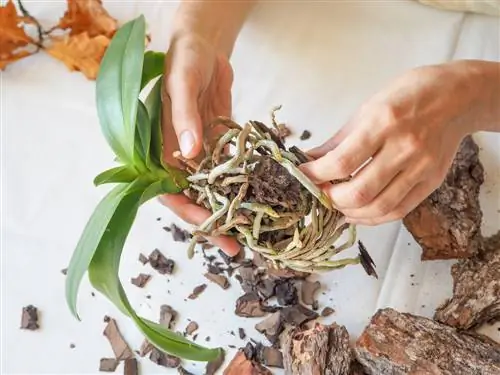
If the orchid soil becomes moldy, it should be completely removed and the orchid repotted
The best orchid soil is not immune to mold. Various causes cause the damage. Purchased and self-made substrates are equally affected. If there is a fluffy, soft coating on the surface, the entire substrate volume has long been infected with mold spores. Repotting immediately into fresh bark substrate solves the problem. The right materials and tools as well as expert preparation simplify the procedure. The following instructions explain how to properly repot a moldy orchid:
Material and tool requirements
- Bucket or deep bowl
- liquid orchid fertilizer
- stale tap water or filtered rainwater
- new, transparent culture pot
- Orchid soil
- inorganic drainage material, lava granules, expanded clay, pottery shards
- freshly sharpened, disinfected bypass scissors
Instead of investing in a new culture pot, you can clean and disinfect the current pot. To remove all mold spores, Sagrotan, vinegar water, brush and sponge are required.
Preparation makes roots supple
Stubborn aerial roots are the biggest problem when repotting moldy orchids. There is a great risk of damage to the root strands. You can avoid this risk by giving your orchid a water bath in advance. Flexible roots are easier to manage and easier to untangle. This is how it works:
- Removing the culture pot from the planter
- fill room temperature water into a bucket
- ideally add a good dash of liquid orchid fertilizer
- Place the orchid and its culture pot in the water until no more air bubbles appear
Step-by-step instructions
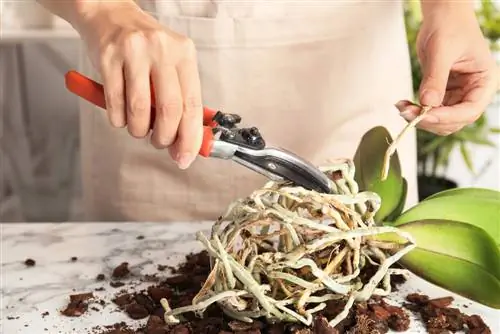
Dead roots should be removed when repotting
When the orchid leaves the water bath, start repotting immediately. How to proceed correctly step by step:
- grab the root neck with one hand, grab the culture pot with the other hand
- Slowly pull the orchid out of the pot (if there is resistance, knead the pot)
- Shake off moldy substrate, rinse off any remaining residue
- Put the substrate-free root ball on the table and inspect it
- cut off moldy, rotten, dead roots
- Fill drainage material as thick as a finger into a new or cleaned culture pot
- Place a handful of orchid soil over the drainage
- Place the orchid in the pot with a twisting motion
Stabilize the orchid with one hand while adding more substrate around the root ball with the other hand. To ensure that coarse and fine components are distributed evenly, knock the culture pot onto the table top from time to time. It is important to note that you plant the orchid just as deep as before. The preparatory immersion bath has covered the plant's current water needs. Therefore, the stressed orchid can regenerate in peace in the partially shaded window seat.
Prevent mold on orchid soil - This is how it works
Orchid soil is spared from mold with targeted prevention. The main cause of the dilemma is too much moisture, caused by excessive watering and high humidity. If mold appears for the first time, repotting immediately will only temporarily solve the problem. To prevent penetrant mold spores from spreading again on orchid soil, these precautions help:
- Wate or dip orchids only when the substrate is noticeably dry
- Spray leaves, aerial roots and bulbs more often
- water sparingly and little by little in winter
- Repot every one to two years in fresh, steamed orchid soil
Constant humidity of 40 to 50 percent makes life difficult for mold spores. Most types of orchids for the windowsill can live very well with this value. If you often struggle with moldy orchid substrate, it is worth investing in a hygrometer to regulate the humidity in a timely manner.
Tip
White animals in orchid soil put the worried hobby gardener on alert. These are mostly springtails, which only catch the eye in larger numbers with a body length of 0.1 mm or more. The whitish tiny creatures feed on rotting plant materials and are actually considered beneficial insects. To prevent mass proliferation, immerse the culture pot in room temperature water for a few minutes and skim off the floating springtails.
Frequently asked questions
Which orchid soil is the best?
The premium product from GREEN24 emerged as the test winner for the best orchid soil. The manufacturer attaches great importance to fresh bottling for every order, uses high-quality products and does not add peat. It is advantageous to choose from three different grain sizes: fine, medium and coarse.
Can you make your own orchid soil?
Almost all orchid gardeners with experience make their own orchid soil. It is a mixture of pieces of bark (mostly pine bark) as the main ingredient, supplemented with organic and inorganic additives. For the popular medium-sized Phalaenopsis orchid, a composition of 50-60 percent medium-coarse pine bark, 20 percent coconut fibers, 10 percent lava granules, 10 percent sphagnum moss and 10 percent charcoal has proven successful in practice.
Does it have to be expensive pine bark if I want to make my own orchid soil?
No, orchids do not insist on pine bark in the substrate. Pieces of bark from tree species such as oak, ash, pine or Douglas fir are conceivable. More important than the type of tree is an adequate grain size of the bark pieces, tailored to the orchid in question. Medium-sized Phalaenopsis prefer a grain size of 7 to 35 mm. Trendy mini orchids can hold on to pieces of bark measuring 2 to 4 mm with their roots. Majestic orchids want coarse orchid soil with a grain size of 35 to 50 mm for their thick roots.
When is the best time to repot a Phalaenopsis in fresh orchid soil?
If the Phalaenopsis takes a break from flowering, the ideal time window for repotting opens. In our regions this is usually an appointment in spring every 2 to 3 years. You can use various indicators to tell whether your orchid wants to move to fresh substrate and a larger culture pot. If aerial roots grow over the edge of the pot or peek out of the opening in the ground, it's the best option. You should also repot the butterfly orchid when the pieces of bark in the substrate clearly decompose into granular humus.
Can you plant orchids in regular potting soil?
Planting orchids in conventional potting soil reliably kills the exotic flowers. Most orchid species thrive as epiphytes with aerial roots. In the treetops of rainforests, the plants sit on branches, hold on with some roots and catch the rain with other roots. Fine, crumbly potting soil does not allow orchid roots any room to breathe, so the exotic beauties die within a short time.
Tip
White coating on orchid soil does not necessarily have to be mold. Hard, calcareous irrigation water leaves behind comparable residues, which of course do not require complex repotting. A simple rapid mold test sheds light on the matter. Scrape the suspicious coating with a toothpick or match. Hard, crumbly texture indicates limescale deposits. A fluffy, soft consistency reveals mold infestation. Remove the layer of earth with lime incrustations and refill with fresh orchid soil. From now on, water your orchid with soft, low-lime water.

